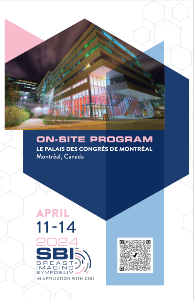Initial Clinical Experience with Contrast Enhanced Digital Breast Tomosynthesis (CEDBT)
ePosters

Samar Naamo, MD
Resident Physician
Stony Brook University
Presenter(s)
Background: Contrast enhanced digital mammography (CEDM) reveals neovascularity of breast lesions using iodinated contrast, increasing conspicuity of mammographic lesions. Digital breast tomosynthesis (DBT) reduces recalls and increases cancer detection by minimizing superimposition of overlying breast tissues. The combination of CEDM and DBT into a single technique, CEDBT, could potentially integrate the strengths of both, providing better anatomical morphology and vascular information. Data on CEDBT has been limited thus far. We utilized a prototype CEDM/CEDBT system with new, optimized x-ray filters (30% thicker titanium) for low and high energy image acquisitions. This study assesses the clinical feasibility of CEDBT and correlates lesion enhancement characteristics and morphology on CEDBT to digital mammography (DM), DBT, CEDM, and magnetic resonance imaging (MRI).
Learning Objectives: Describe image acquisition and processing techniques for CEDM and CEDBT.
Correlate breast lesion enhancement and morphology obtained on CEDBT to DM, DBT, CEDM and MRI.
Demonstrate the clinical use of CEDBT in detecting breast cancer in dense breasts compared to DM, DBT, CEDM and MRI.
Demonstrate clinical feasibility and benefits of CEDM and CEDBT over MRI in terms of lower false positives, lower cost, wider availability and more direct correlation with conventional mammography for biopsy and localization purposes.
Abstract Content/Results: CEDBT and CEDM are superior to DM and DBT in identifying and characterizing breast lesions (cases: 1). CEDBT and CEDM demonstrate similar lesion margin, shape and conspicuity compared to MRI (cases: 1).
Sensitivity of DM is significantly decreased in dense breasts. Our CEDBT cases demonstrate lesion conspicuity and sensitivity similar to MRI, and better than DM, CEDM and DBT in dense breasts (cases: 2,3).
CEDBT combines the strengths of CEDM and DBT and demonstrates better diagnostic performance than either modality alone. Our CEDBT cases demonstrate improved lesion margin, shape and conspicuity compared to DM, DBT, and CEDM (cases: 3,4).
MRI is the most sensitive modality for breast cancer screening but is limited by low specificity and high false positive rates. While CEDBT has high sensitivity for breast lesions like MRI, CEDBT demonstrates fewer false-positives and higher specificity compared to MRI (cases: 4,5). CEDBT could be valuable for assessing the extent of breast cancer and high-risk screening.
Conclusion: CEDBT provides morphologic and vascular characteristics of breast lesions qualitatively superior to DM and DBT, and similar to MRI. CEDBT may be a potential alternative option to MRI with benefits of high sensitivity, lower costs, and lower false positives.
Learning Objectives: Describe image acquisition and processing techniques for CEDM and CEDBT.
Correlate breast lesion enhancement and morphology obtained on CEDBT to DM, DBT, CEDM and MRI.
Demonstrate the clinical use of CEDBT in detecting breast cancer in dense breasts compared to DM, DBT, CEDM and MRI.
Demonstrate clinical feasibility and benefits of CEDM and CEDBT over MRI in terms of lower false positives, lower cost, wider availability and more direct correlation with conventional mammography for biopsy and localization purposes.
Abstract Content/Results: CEDBT and CEDM are superior to DM and DBT in identifying and characterizing breast lesions (cases: 1). CEDBT and CEDM demonstrate similar lesion margin, shape and conspicuity compared to MRI (cases: 1).
Sensitivity of DM is significantly decreased in dense breasts. Our CEDBT cases demonstrate lesion conspicuity and sensitivity similar to MRI, and better than DM, CEDM and DBT in dense breasts (cases: 2,3).
CEDBT combines the strengths of CEDM and DBT and demonstrates better diagnostic performance than either modality alone. Our CEDBT cases demonstrate improved lesion margin, shape and conspicuity compared to DM, DBT, and CEDM (cases: 3,4).
MRI is the most sensitive modality for breast cancer screening but is limited by low specificity and high false positive rates. While CEDBT has high sensitivity for breast lesions like MRI, CEDBT demonstrates fewer false-positives and higher specificity compared to MRI (cases: 4,5). CEDBT could be valuable for assessing the extent of breast cancer and high-risk screening.
Conclusion: CEDBT provides morphologic and vascular characteristics of breast lesions qualitatively superior to DM and DBT, and similar to MRI. CEDBT may be a potential alternative option to MRI with benefits of high sensitivity, lower costs, and lower false positives.

